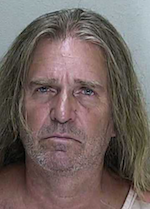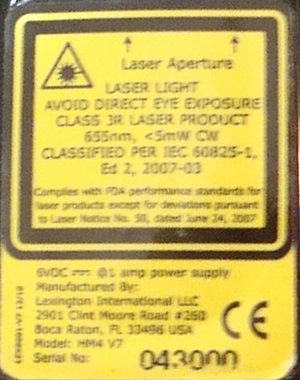Home
A comprehensive resource for safe and responsible laser use
US: Florida man aims "laser comb" at helicopter, is arrested
The helicopter crew radioed ground officers, who arrested Mark A. Geohagan, 55, of Ocala. He told officers it was “not a laser” but a laser comb. Geohagan said he was testing the distance the light could reach, and that he meant no harm. Geohagan was charged a few hours later with pointing a laser light at a driver or pilot.

Mark A. Geohagan. His middle name was variously reported as “Allen” or “Albert”
The Bosley LaserComb Elite used by Geohagan has nine red 650nm laser diodes arranged in a line, that normally are directed towards a person’s scalp. When aimed into space, it produces a single, “extremely bright” spot of light as described in more detail after the “Read More…” link below.
From the Ocala StarBanner and Orlando Sentinel. Thanks to Chuck Maricle, Ph.D., for background information on hair comb products. For additional description and analysis of laser combs, click the “read more…” link.
Additional description and analysis by LaserPointerSafety.com

The photo above shows a Bosley LaserComb Elite, retailing for about $500. According to Lauren Lettelier, public information officer for the Marion County Sheriff’s Office, this is the type of device that was aimed at the helicopter: a Bosley LaserComb Elite model HM4 V7.

The scalp-facing side has nine lasers arranged in a single row, as shown above in a photo of another model HM4 V7 (not Geohagan’s device).

This is the label from a Bosley LaserComb Elite, model HM4 V7. It indicates the laser is Class 3R, meaning the laser light output does not exceed 5 milliwatts. This is likely 5 mW per laser emitter, since each beam would focus on a different part of the eye, and thus safety classification would probably be based on the worst case for a single beam.
Light spread from a laser comb
A Marion County Sheriff’s Office evidence technician described the light output from Geohagan’s device as being separate dots or spots at a distance of about 4-6 inches, merging into a single “extremely bright” spot of light at roughly a foot away.
Leonard Stillman, a representative for Lexington International, which makes laser combs under the Bosley and HairMax names, told LaserPointerSafety.com “It’s not like a laser pointer, it will start to diffuse as it goes out. But when you do hold it up from the skin you are getting diffusion…. It is designed to function close to the skin but not at a distance.”
Stillman provided additional information on the laser comb: “The focal point is within 15 mm of the laser source, and provides a divergent beam. At 2 meters, each laser spot size is over 15 sq. cm.” He also noted “We have not calculated or measured the NOHD [Nominal Ocular Hazard Distance] as the FDA has determined that Class 3R lasers are safe for direct sale to the general public.”
Each of the nine diodes would have a very large divergence (spread) of roughly 20 milliradians. At a distance of 200 feet — a possible ground-to-helicopter distance — each of the nine beams would be more than 4 feet wide. It is not known if at that distance the beams are superimposed into a 4-foot-wide tight spot of light, or if the beam aiming varies enough to make a larger, dimmer, softer zone of light.
Calculating a worst-case (most hazardous) light source
As a simplifying, worst-case example, assume there is one 45 mW laser with a 20 mrad divergence. (This is similar to superimposing nine 5 mW beams into a single 4-foot-wide spot of light — the tightest and brightest possible light.) According to standard FAA calculations, the resulting light could cause temporary flashblindness up to 39 feet away, and could produce veiling glare up to 175 feet away.
The light could not have caused injury to the helicopter pilot; the NOHD would be less than 8 feet. And note that this is for the simplified 45 mW single laser; the NOHD for the actual Bosley LaserComb Elite would be even less due to the arrangement of the nine laser diodes. (Very roughly, the NOHD for a single 5 mW laser with 20 mrad divergence is 2.5 feet.)
The helicopter pilot indicated that he had “temporary blindness.” Yet according to the calculations above, he would need to be within 39 feet of the simplified worst-case laser in order to be flashblinded. It is unlikely he was flying this close to the laser comb. So how can this discrepancy be reconciled?
It could be that Geohagan’s laser comb had characteristics different from the ones provided by Lexington International. Or it could be that the helicopter pilot was informally stating the severity of the light. For example, if by “temporary blindness” perhaps he meant he couldn’t see the ground while the light was on him, which actually corresponds to the FAA definition of “glare.” (Flashblindness is defined as having an afterimage, a spot that remains even when the light goes away. It is essentially the same as when a camera flash goes off close to your face and leaves a spot that then fades over time.)
Manufacturer safety cautions
Bosley’s website FAQ lists the following warnings and cautions:
- Do not stare at the laser light.
- Do not stare at the laser light reflected from any reflective surface or shine the laser in or around your eyes.
- Keep out of reach of children. Do not allow minors to use lasers.
- Never shine a laser at anyone.
- Do not point a laser at mirror-like surfaces. A reflected beam can act like a direct beam on the eye.
- The use of magnifying optical instruments with this product can cause eye danger.
- Do not attempt to repair, enter, alter, or interfere in any way with the workings of this appliance or any part of this appliance.
- Use controls and performance procedures only as specified.
The Lexington International FAQ webpage asks and then answers two questions about safety:
- Q: Is the HairMax safe to use? A: In clinical studies and in general use since 2001, there has never been any report of serious adverse events occurring.
- Q: What about visual safety? A: The HairMax LaserComb has been specially designed using low power requirements for maximum attention to visual safety. Avoid direct contact with eyes.
What does a laser comb do?
Finally, for those curious about how a laser comb helps regrow hair, here is information from the Bosley LaserComb Elite webpage:
The Bosley Lasercomb Elite® works via the principle of photo-biostimulation, a process which delivers laser energy to the hair follicle. The light energy emitted from the Bosley Lasercomb Elite® may increase blood flow and circulation within the scalp and in doing so, revitalize individual follicles and promote a general strengthening of the hair. Blood flow is crucial to promoting healthy hair growth; it brings important nutrients into the follicle, while allowing the follicular cells to effectively dispose of detrimental waste products.
The Bosley Lasercomb Elite® is hand held, cordless and easy to use. This LaserComb features a sleek ergonomic design with a rechargeable lithium ion battery to give you the freedom of movement as you treat your hair. The Bosley Lasercomb Elite® works directly on your scalp by parting your hair with two rows of teeth. The teeth are aligned with a row of laser beams. The teeth part your hair forming a clear path for the light to reach the scalp during use. Simply use the LaserComb on thinning areas of the scalp for 10 -15 minutes, three times per week. Though not ideal for the treatment of advanced hair loss, the Bosley Lasercomb Elite® is a convenient method to obtain the very best results after hair restoration surgery and to maintain existing hair.